-
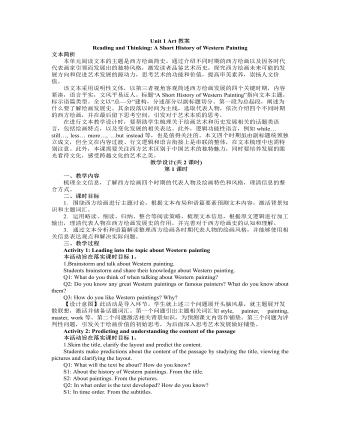
新人教版高中英语选修3Unit 1 Art教案
[2] An important breakthrough…was… [3] Another innovation was … [4] the emphasis increasingly shifted from…to… [5] New ideas and values gradually replaced… [6] While his paintings still had religious themes… … T: All these expressions serve to show how Western painting has developed. Some of them share similar structure but with varied use of words, which makes the text vivid and more readable. 【设计意图】主题类语言整理有助于学生类化语言应用,提高语言输出的丰富性。处理完文本内容信息后,进入语篇信息处理,进行主题相关的词块归类。引导学生快速阅读,寻找表达相同主题(发展或者艺术)的词和短语,再根据词性、用法和结构进行归类,储备主题相关词汇,丰富语言储备,提升语言素养。 Assignment: Go online to gather more information about Chinese painting and write a short history of it. 【设计意图】结合所学,迁移运用,根据实际语境,进行模仿性运用。在此过程中,学生尝试借鉴已学的语言、内容、语篇结构和写作手法来建构新文本,实现语篇输出,同时关注中西艺术文化的差别,加深对优秀文化的认同,培养文化意识。
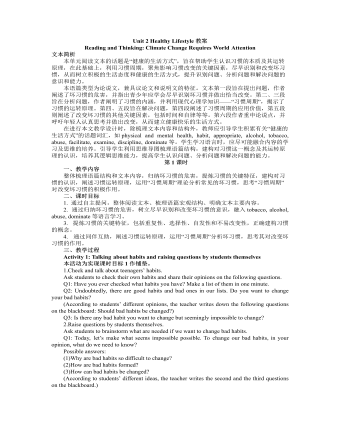
新人教版高中英语选修3Unit 2 Healthy Lifestyle教案
Activity 4: Figuring out the structure and the writing purpose 本活动为实现课时目标2。 1.Read Paragraph 6 and think about its main idea and the writer’s writing purpose. Q1: If you were the author, how would you end your article? “For young people, there is plenty of time to change bad habits. However, there is no “magic pill” or delete button that will help you; you have to think about your bad habits and decide on some changes. You have the power to build a happy and healthy life full of good habits!” Q2: What is Paragraph 6 mainly about? (Possible answer: to appeal to young people including teenagers to change bad habits and live a happy and healthy life.) 2.Think about the writer’s writing purpose and share opinions. Q1: What is the writing purpose? Work in pairs and figure it out. (Possible answer: On the one hand, the passage is written to help teenagers change their bad habits and live a healthy lifestyle. On the other hand, it provides us with a scientific way to identify and analyse our problems objectively, thus strengthening our resolve to tackle the seemingly common yet tough problems in our lives.) 【设计意图】 步骤1旨在预测和验证文章最后一段主要内容,梳理完整的语篇结构,步骤2旨在思考和讨论作者的写作目的。教师也可根据学生课堂反应情况融入对语篇人称多次转换的思考。
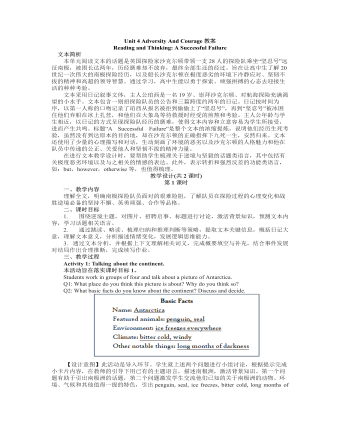
新人教版高中英语选修3Unit 4 Adversity And Courage教案
本活动旨在落实课时目标3。 The Student Union is looking for three students for a 3-week voluntary program in Guizhou province. The volunteers have got to be high school students, with a persevering personality and experiences in overcoming adversity. The volunteers need to stay, eat and teach with 20 pupils in a small school up on the hill of a village. There are no facilities but desks and a blackboard in the school. And there is no take-away food to be bought anywhere; the only way to feed yourself is to cook. You’re interested in applying. Write your application letter introducing what adversity you have ever overcome and how persevering you are as well as what you want to do when at work. Dear Student Union,【设计意图】此任务旨在迁移一、二课时所学,解决实际问题。学生对比自己经历过的挑战或挫折,写信给学生会申请前往贵州担任短期支教教师,把个人以前是怎么战胜挫折的经过书写出来。结合所学,迁移创新,分析解决自身实际问题,在真实情境中学生通过仿写进行主题语言的精确输出。完成任务的过程中,能较多地使用已学语言、内容、结构和写作手法来描述自己面对挫折的处理方式、态度和应有的品质,近一步激发学生树立正确的价值观,学会逆境出人才,坚忍不拔,从容不迫,又做到谦让、分享和合作。课后学生修正习作,再次提交。
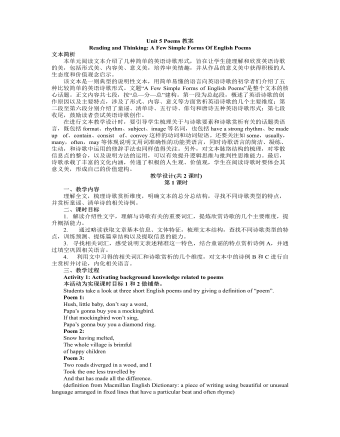
新人教版高中英语选修3Unit 5 Poems教案
本单元阅读文本介绍了几种简单的英语诗歌形式,旨在让学生能理解和欣赏英语诗歌的美,包括形式美、内容美、意义美,培养审美情趣,并从作品的意义美中获得积极的人生态度和价值观念启示。 该文本是一则典型的说明性文本,用简单易懂的语言向英语诗歌的初学者们介绍了五种比较简单的英语诗歌形式。文题“A Few Simple Forms of English Poems”是整个文本的核心话题。正文内容共七段,按“总—分—总”建构。第一段为总起段,概述了英语诗歌的创作原因以及主要特点,涉及了形式、内容、意义等方面赏析英语诗歌的几个主要维度;第二段至第六段分别介绍了童谣、清单诗、五行诗、俳句和唐诗五种英语诗歌形式;第七段收尾,鼓励读者尝试英语诗歌创作。 在进行文本教学设计时,要引导学生梳理关于与诗歌要素和诗歌赏析有关的话题类语言,既包括format、rhythm、subject、image等名词,也包括have a strong rhythm、be made up of、contain、consist of、convey这样的动词和动词短语。
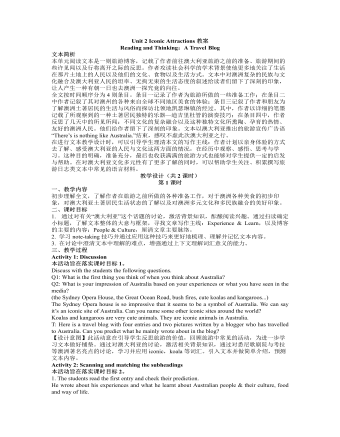
新人教版高中英语选修4Unit 2 Iconic Attractions教案
帮助学生通过讨论与对主题的提升,反思自己的旅游方式,以便做出更优化的安排,在今后的旅程中有更多的收益。 Activity 2: Further discussion of the 6 elements above and supplement of more background knowledge 本活动为实现课时教学目标2。 1.Target Q: The writer’s clear target of traveling, meeting the people and experiencing the culture, is closely related to his major in social studies. Then what is social studies? Social studies is a part of a school or college curriculum concerned with the study of social relationships and the functioning of society and usually made up of courses in history, government, economics, civics, sociology, geography, and anthropology. (Dictionary by Merriam-Webster) Reflection: When you go out to travel, what targets do you usually have in mind? 2.Research Q: Suppose you are traveling to Hangzhou during the school holidays, how will you do research on the city? (surf the internet, read books or travel brochures, consult friends, ...) What information will you be interested to know? (location, iconic sites, local cuisines, interesting customs, shopping malls ...) 3.Abandonment To make the most of time, we have to learn to abandon so that we can accomplish our plan. What will you be interested in doing if you go to Hangzhou if you have a week’s time? What if you only have 2 days? 4~5. Venturing & Experiencing Q: What did he venture to do during the trip? What new experiences did he have? In Sydney: attend his first open-air barbecue, enjoy many different but yummy meals In Catherine: observe the life and customs of the aborigines appreciate their music & try the musical instruments: the didgeridoo
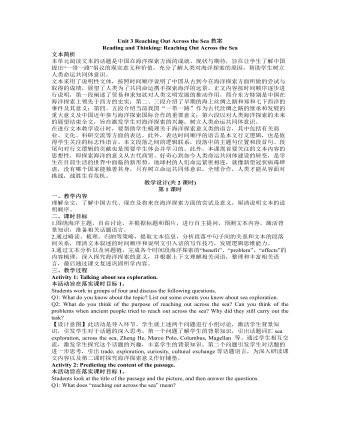
新人教版高中英语选修4Unit 3 Reaching Out Across the Sea教案
本活动旨在落实课时目标3。 Think about the following questions and talk about your own attitude in pairs.Q1: As for this topic,what impresses you the most in the passage?Q2: What do you think of the future of China’s further exploration in sea? Are you in favor of the further exploration?Why or why not? 【设计意图】该活动是一个完全开放性的活动,每个学生都会有不同的答案。运用迁移所学,自由口头表达自己对海洋探索的态度。对于中国海洋探索的未来,每个人的想法是不一样的,有乐观,有担忧,有认为值得投入,也有认为不值得付出太大代价,这里给学生自由表达的空间只要学会有支撑自己观点的事实就可以了,进一步培养学生批判性思维和正确的价值观。 Assignment: 此任务旨在迁移一、二课时所学,培养学生辩证分析问题的能力。 Write about your idea of the future of China’s sea exploration. And add your attitude towards the effort China have made in sea exploration. You’re expected to use the language and the writing technique learnt in the passage.
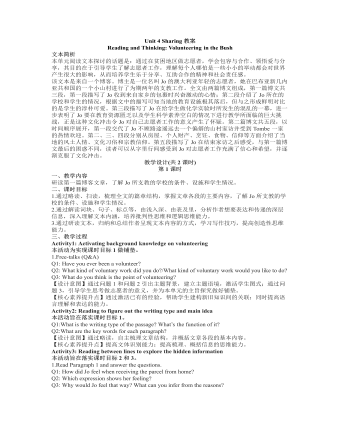
新人教版高中英语选修4Unit 4 Sharing教案
【核心素养提升点】学会将抽象信息进行可视化表达,提高信息处理能力和分析、推理等高阶思维品质;在跨文化交际中学会以国际视野接受和包容不同的文化。 5.Read Paragraph 2, draw a mind map and answer the questions. Q1:What did Jo learn about Tombe’s life? Q2:What kind of life do the natives lead? Read paragraph 2-5 and draw a mind-map. (Focus on accommodation, possession, diet and belief) 【设计意图】引导学生利用思维导图和问题链等形式来厘清当地人的生活方式,更好地处理和归纳信息 【核心素养提升点】提高信息处理能力、分析和归纳能力,包容异国文化、扩展国际视野。 6.Read Paragraph 3 and answer the questions. Q1:What was Jo’s feeling upon arriving her own home? Q2:Why would she feel that way? Q3:Do you think “It was such a privilege to have spent a day with Tombe’s family”? 【设计意图】通过提问,让学生理解Jo的苦并快乐的心情,并通过对“It was such a privilege to have spent a day with Tombe’s family”这句话的理解,体验志愿者生活的伟大。 【核心素养提升点】学会对信息的综合和归纳,从而理解作者所表达的观点。 Activity4: Summarize the change of Jo's feelings
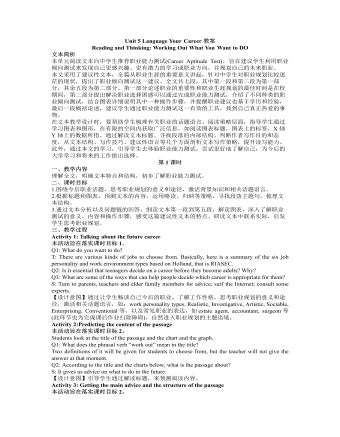
新人教版高中英语选修4Unit 5 Language Your Career教案
本单元阅读文本向中学生推荐职业能力测试(Career Aptitude Test),旨在建议学生利用职业倾向测试来发现自己更感兴趣、更有潜力的学习或职业方向,并规划自己的未来职业。 本文采用了建议性文本,全篇从职业生涯的重要意义讲起,针对中学生对职业规划比较迷茫的现状,提出了职业倾向测试这一建议。全文共七段,其中第一段和第二段为第一部分,其余五段为第二部分。第一部分论述职业的重要性和职业生涯规划的最佳时间是在校期间,第二部分提出解决职业选择困惑可以通过完成职业能力测试,介绍了不同种类的职业倾向测试,结合图表详细说明其中一种操作步骤,并提醒职业建议也基于学历和经验,最后一段概括论述,建议学生通过职业能力测试这一有效的工具,找到自己真正热爱的事物。 在文本教学设计时,要帮助学生梳理有关职业的话题语言。阅读策略层面,指导学生通过学习图表和图形,在有限的空间内获取广泛信息,如阅读图表标题,图表上的标签,X轴Y轴上的数据所指。
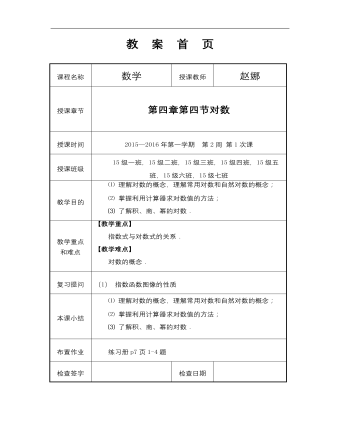
【高教版】中职数学基础模块上册:4.3《对数》优秀教案
课程名称数学授课教师赵娜授课章节第四章第四节对数授课时间2015—2016年第一学期 第2周第1次课授课班级15级一班,15级二班,15级三班,15级四班,15级五班,15级六班,15级七班教学目的⑴ 理解对数的概念,理解常用对数和自然对数的概念; ⑵ 掌握利用计算器求对数值的方法; ⑶了解积、商、幂的对数.教学重点 和难点【教学重点】 指数式与对数式的关系. 【教学难点】 对数的概念.复习提问(1) 指数函数图像的性质本课小结⑴ 理解对数的概念,理解常用对数和自然对数的概念; ⑵ 掌握利用计算器求对数值的方法; ⑶了解积、商、幂的对数.布置作业练习册p7页1-4题检查签字 检查日期

【高教版】中职数学基础模块上册:2.2《区间》优秀教案
【教学目标】1、掌握区间的概念;2、用区间表示相关的集合;3、通过数形结合的学习过程,培养学生的观察能力和数学思维能力。【教学重点】区间的概念【教学难点】 区间端点的取舍【教学设计】 1、实例引入知识,提升学生的求知欲;2、数形结合,提升认识;3、通过知识的巩固与练习,培养学生的思维能力【课时安排】 1课时(45分钟)【教学过程】² 创设情景 兴趣导入问题:资料显示:随着科学技术的发展,列车运行速度不断提高.运行时速达200公里以上的旅客列车称为新时速旅客列车.在北京与天津两个直辖市之间运行的,设计运行时速达350公里的京津城际列车呈现出超越世界的“中国速度”,使得新时速旅客列车的运行速度值界定在200公里/小时与350 公里/小时之间.如何表示列车的运行速度的范围??解决:不等式:200<v<350;集合:;数轴:位于200与3之间的一段不包括端点的线段;还有其他简便方法吗?
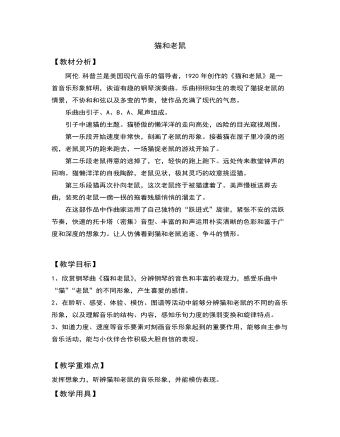
二年级音乐欣赏猫和老鼠教案教学设计
阿伦.科普兰是美国现代音乐的倡导者,1920年创作的《猫和老鼠》是一首音乐形象鲜明,诙谐有趣的钢琴演奏曲。乐曲栩栩如生的表现了猫捉老鼠的情景,不协和和弦以及多变的节奏,使作品充满了现代的气息。乐曲由引子、A、B、A、尾声组成。引子中速猫的主题。猫骄傲的懒洋洋的走向高处,凶险的目光窥视周围。第一乐段开始速度非常快,刻画了老鼠的形象。接着猫在屋子里冷漠的巡视,老鼠灵巧的跑来跑去,一场猫捉老鼠的游戏开始了。第二乐段老鼠得意的逃掉了,它,轻快的跑上跑下。远处传来教堂钟声的回响。猫懒洋洋的自我陶醉,老鼠见状,极其灵巧的故意挑逗猫。第三乐段猫再次扑向老鼠,这次老鼠终于被猫逮着了。美声慢板送葬去曲,装死的老鼠一瘸一拐的拖着残腿悄悄的溜走了。在这部作品中作曲家运用了自己独特的“跃进式”旋律,紧张不安的活跃节奏,快速的托卡塔(密集)音型、丰富的和声运用朴实清晰的色彩和富于广度和深度的想象力。让人仿佛看到猫和老鼠追逐、争斗的情形。
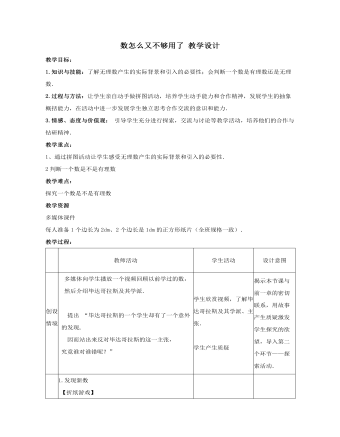
无理数教材教案
1、举例而生活还有类似的例子吗?2、为了加固一个高2米、宽1米的大门,需要在对角线位置加固一条木板,设木板长为a米,a的值可能是整数吗?a的值可能是分数吗?3、2.如下图B,C是一个生活小区的两个路口,BC长为2千米,A处是一个花园,从A到B,C两路口的距离都是2千米,现要从花园到生活小区修一条最短的路,这条路的长可能是整数吗?可能是分数吗?说明理由.4、上图是由16个边长是1的小正方形拼成,任意连接小正方形的若干个顶点,得到一些线段.试分别找出长度是有理数的线段和长度不是有理数的线段.你还能找到其他长度不是有理数的线段吗?
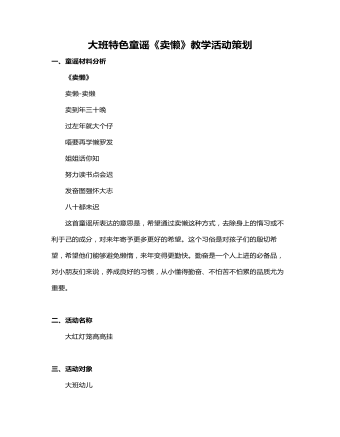
《卖懒》教学设计教案
1.制作红灯笼师:(展示漂亮的灯笼)小朋友们想不想自己亲手制作一个呢?生:好呀师:那小朋友们知道制作灯笼需要什么材料吗?生:彩纸、剪刀...师:没错,那老师先来展示一下怎么制作灯笼吧!(展示完后,开始让小朋友两两组合共同制作)2.制作灯笼剪纸师:小朋友们,刚刚是不是已经制作灯笼了呀?下面我们进行一个更好玩的环节?生:好呀好呀!师:那我先来展示一下咯,小朋友们别眨眼呀!(展示完后,开始让小朋友们独立完成)小结:通过制作共同合作制作灯笼与独自完成灯笼剪影,不仅使他们更能感知灯笼的形状,更能提高小朋友们的动手能力和思考力。
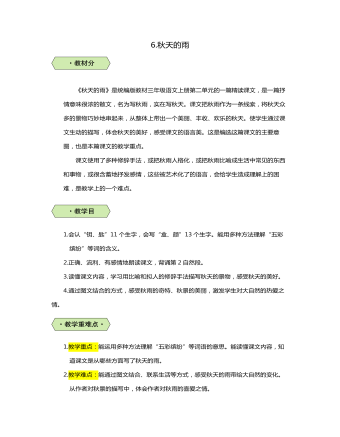
秋天的雨教案
《秋天的雨》是统编版教材三年级语文上册第二单元的一篇精读课文,是一篇抒情意味很浓的散文,名为写秋雨,实在写秋天。课文把秋雨作为一条线索,将秋天众多的景物巧妙地串起来,从整体上带出一个美丽、丰收、欢乐的秋天。使学生通过课文生动的描写,体会秋天的美好,感受课文的语言美。这是编选这篇课文的主要意图,也是本篇课文的教学重点。课文使用了多种修辞手法,或把秋雨人格化,或把秋雨比喻成生活中常见的东西和事物,或很含蓄地抒发感情,这些被艺术化了的语言,会给学生造成理解上的困难,是教学上的一个难点。
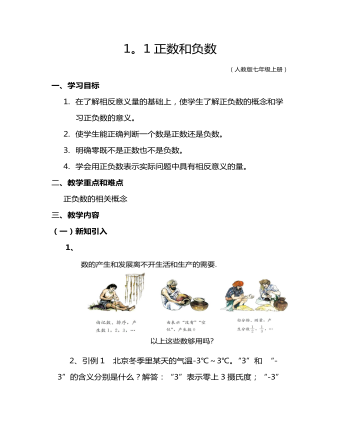
正数和负数教案
1、根据3、-3、3。5、-4。5、-5。2、8。5、4。0、-1。2引出正数和负数的定义及特征性质。① 像3、3。5这样大于0的数叫做正数;② 像-3、-4。5这样在正数前面加上符号“-”的数叫做负数。③ 根据需要,有时在正数前面加“+”号,例如+3、+2、+0。5……,就是3、2、0。5……。④ 一个数前面的“+”和“-”号叫做它的符号。⑤ 注意:0既不是正数,也不是负数.2、通过课堂练习1和课堂练习2引出相反意义的量的定义、《活学巧计》诗及做类似题时的方法总结。① 在生活中存在各种各样的量,其中有一种量,它们的属性相同(即同类量),但表示的意义却相反,我们把这样的量叫做相反意义的量.② 活学巧记 相反意义量成对,还要数量和单位, 你为正来我为负,正负兄弟齐上阵。
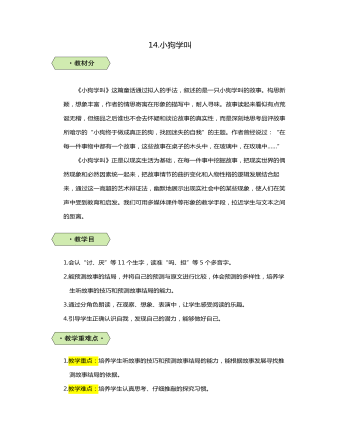
小狗学叫教案
《小狗学叫》这篇童话通过拟人的手法,叙述的是一只小狗学叫的故事。构思新颖,想象丰富,作者的情思寄寓在形象的描写中,耐人寻味。故事读起来看似有点荒诞无稽,但细品之后谁也不会去怀疑和谈论故事的真实性,而是深刻地思考品评故事所暗示的“小狗终于做成真正的狗,找回迷失的自我”的主题。作者曾经说过:“在每一件事物中都有一个故事,这些故事在桌子的木头中,在玻璃中,在玫瑰中……” 《小狗学叫》正是以现实生活为基础,在每一件事中挖掘故事,把现实世界的偶然现象和必然因素统一起来,把故事情节的曲折变化和人物性格的逻辑发展结合起来,通过这一高超的艺术辩证法,幽默地展示出现实社会中的某些现象,使人们在笑声中受到教育和启发。我们可用多媒体课件等形象的教学手段,拉近学生与文本之间的距离。
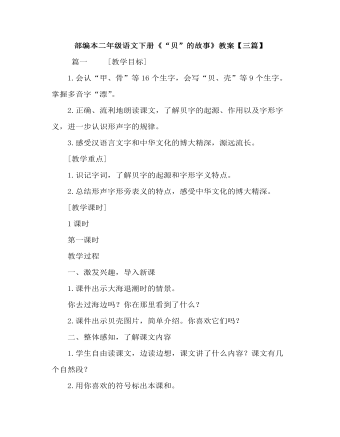
《“贝”的故事》教案
教学目标: 1、会认“甲、骨、类”等16个生字,会写“贴、街、扫”等9个生字,会写“贝壳、甲骨文、样子、可以、钱币、钱财、有关”等词语, 2、默读课文,了解贝字的起源,贝的作用以及字形字义。 一、激趣引入。 1、观察,说说你的发现。 (1)流、泪、河、江(2)说、话、记、读 (3)树、杨、李、林(4)购、货、赠、赚 2、说说你的发现。 生1:第一组的字都是“氵”,三点水的字都与水有关。 生2:第二组的字都是“讠”,言字旁的字都与说话有关。 生3:第三组的字都是“木”,木字旁的字都与树木有关。 生4:第四组的字都是“贝”,贝字旁的字都与钱有关。 3、师:孩子们真聪明,观察得非常仔细。今天,我们就要学习一篇与贝有关的课文。 4、揭示课题:3、贝的故事。
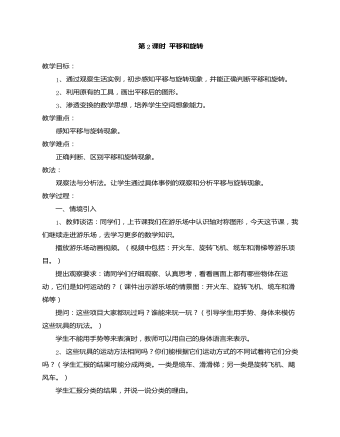
《平移和旋转》教案
1、生活中的平移。谈话:平移和旋转都是物体或图形的位置变化。平移就是物体沿直线移动。像缆车是向前平移,滑滑梯是向斜方向平移,你瞧,这里有一个观光电梯,它是什么运动?(平移) 师:说得真棒,瞧,我们学校的观光电梯,它的上升、下降,都是沿着一条直线移动,就是平移。只要是物体或图形沿着直线移动,就是平移。谈话:我们的生活中有很多这样的平移现象,(教师走到窗户旁)你瞧,老师把窗户打开,这个推开窗户的运动是什么现象?(平移)对了,这是平移,那么在生活中你还见过哪些平移现象吗?举例说说。让学生先说给同组的同学听,再指名回答。师:你们想亲身体验一下平移吗?(想)全体起立,我们一起来,向左平移2步,向右平移2步。真棒!请坐。我们生活中的平移现象可多了,你能用你桌面上的物体做做平移运动吗?(学生边说边做。)
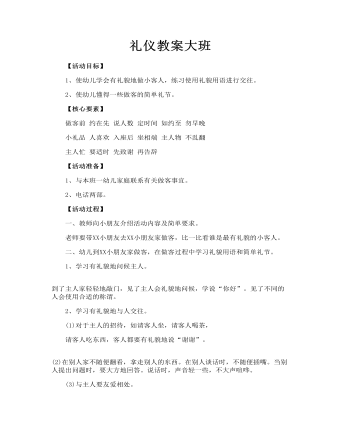
礼仪教案大班
【活动准备】 1、与本班一幼儿家庭联系有关做客事宜。 2、电话两部。 【活动过程】 一、教师向小朋友介绍活动内容及简单要求。 老师要带XX小朋友去XX小朋友家做客,比一比看谁是最有礼貌的小客人。 二、幼儿到XX小朋友家做客,在做客过程中学习礼貌用语和简单礼节。 1、学习有礼貌地问候主人。 到了主人家轻轻地敲门,见了主人会礼貌地问候,学说“你好”。见了不同的人会使用合适的称谓。
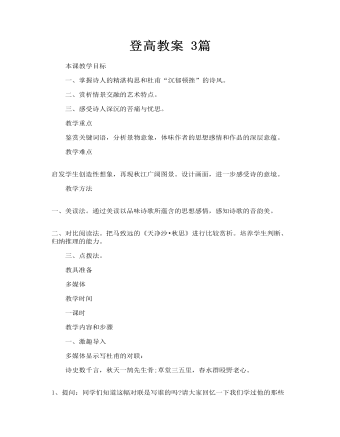
登高教案 3篇
一、激趣导入 多媒体显示写杜甫的对联: 诗史数千言,秋天一鹄先生骨;草堂三五里,春水群殴野老心。 1、提问:同学们知道这幅对联是写谁的吗?请大家回忆一下我们学过他的那些作品?能背诵一首我们共同欣赏吗?(学生背诵)今天我们来学习他的另一首诗歌《登高》(板书)

